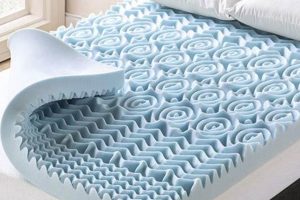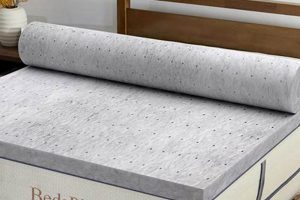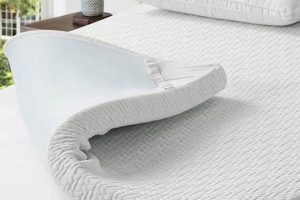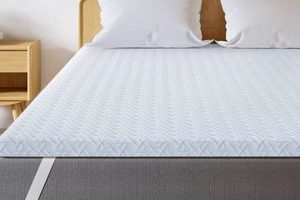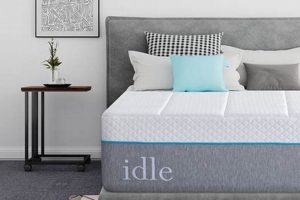A mattress measuring 48 inches in width is a non-standard size, typically falling between a twin and a full mattress. These mattresses are often used in specific applications such as RVs, antique beds, or custom-built furniture where space is a constraint. For example, a camper van may utilize a 48-inch wide mattress to maximize living space within its compact interior.
The utility of this particular width mattress lies in its space-saving characteristics. It offers more sleeping surface than a standard twin, while remaining narrower than a full-size mattress, thus optimizing floor space in smaller rooms or vehicles. Historically, variations in mattress sizes were more common, often dictated by the dimensions of available materials and bed frames. The emergence of standardized sizes simplified manufacturing and consumer purchasing, but niche sizes like this continue to serve specialized needs.
Further exploration will delve into the availability of bedding accessories, the range of comfort options available, and considerations for individuals seeking this unique mattress size, particularly regarding custom orders and potential alternatives.
Guidance on Obtaining a 48-Inch Wide Mattress
Individuals seeking a 48-inch wide mattress should be aware of the limited availability of standardized options. The following guidance outlines key considerations for procuring such a mattress.
Tip 1: Measure the Intended Space Accurately: Prior to initiating a search, precise measurements of the bed frame or intended space are crucial. This ensures the 48-inch width is indeed the optimal dimension and avoids ordering errors.
Tip 2: Explore Custom Mattress Manufacturers: Due to the non-standard size, custom mattress manufacturers are often the most viable source. These companies can create mattresses to the specified width and length, catering to unique spatial requirements.
Tip 3: Inquire About Material Options: Even with custom orders, material choices such as memory foam, innerspring, or latex should be considered. Each material offers varying levels of support and comfort, and the selection should align with individual preferences.
Tip 4: Research Bedding Availability: Standard bedding sizes may not fit a 48-inch wide mattress. Investigate custom bedding options or consider using larger sheets that can be tucked in appropriately.
Tip 5: Compare Pricing Across Manufacturers: Custom mattresses typically incur a higher cost than standard sizes. Obtain quotes from multiple manufacturers to ensure competitive pricing and identify the best value proposition.
Tip 6: Scrutinize Warranty and Return Policies: Before finalizing a purchase, carefully review the warranty and return policies. Given the custom nature, some manufacturers may have limited return options; understanding these conditions is essential.
Tip 7: Consider Mattress Thickness: Determine the desired mattress thickness in relation to the bed frame height and personal preferences. Thicker mattresses may provide more cushioning, but could also raise the overall bed height.
By addressing these considerations, individuals can navigate the challenges associated with acquiring a 48-inch wide mattress and ensure a suitable fit for their specific needs. Careful planning and research are paramount.
The subsequent sections will address common use cases and potential alternatives to this uncommon mattress size.
1. Space Optimization
The selection of a 48-inch mattress is often directly correlated with the imperative for space optimization in confined environments. The dimensions of this mattress size provide a sleeping surface that is broader than a standard twin but narrower than a full-size mattress, rendering it suitable for situations where maximal utilization of available space is paramount. This is especially apparent in recreational vehicles (RVs), studio apartments, and custom-built furniture where interior space is often at a premium. The adoption of this less common size can significantly impact the overall functionality and comfort of the area.
Considering RVs, for example, where interior dimensions are inherently limited, a 48-inch mattress allows for a more comfortable sleeping arrangement than a twin without unduly compromising walkway space or storage capacity. Similarly, in compact urban dwellings or studio apartments, this mattress size enables a full-sized sleeping surface while leaving more room for other essential furnishings and activities. The choice, therefore, reflects a deliberate trade-off between sleeping area and overall room utility, ensuring a more balanced and livable environment. This dimension has also appeared in antique bed frames, highlighting its utility in historic designs.
In essence, the utilization of a 48-inch mattress represents a conscious decision to prioritize efficient space management without sacrificing sleeping comfort entirely. While it may necessitate custom bedding solutions and potentially involve higher costs compared to standard sizes, the resulting improvement in spatial efficiency often justifies these considerations. The practical significance lies in maximizing the usability of compact living spaces, enabling individuals to achieve a more functional and comfortable living arrangement within dimensional constraints.
2. Custom Bedding
The need for custom bedding directly arises from the non-standard dimensions of a 48-inch mattress. Unlike common mattress sizes such as twin, full, queen, or king, the 48-inch width necessitates tailored linens to ensure a proper fit and aesthetic consistency. The prevalence of standardized bedding sizes in retail outlets makes the acquisition of pre-made sheets, blankets, and comforters challenging for owners of these mattresses.
- Sheet Dimensions and Fit
Standard sheet sets are designed to accommodate common mattress dimensions. Consequently, fitted sheets intended for twin-size mattresses are too narrow for a 48-inch width, while full-size sheets are excessively large, leading to ill-fitting bedding that can bunch, slip, and detract from sleeping comfort. Custom sheet sets, conversely, are fabricated to precisely match the mattress dimensions, providing a snug and secure fit. The tailored fit optimizes both comfort and aesthetic appeal. For instance, a custom-fitted sheet will prevent the corners from slipping off the mattress during sleep, a common issue with oversized standard sheets.
- Duvet and Comforter Sizing
Similar sizing issues extend to duvets and comforters. Standard sizes may either be too small, failing to adequately cover the mattress, or too large, resulting in excessive draping and potential entanglement during sleep. Custom-sized duvets and comforters offer a solution by providing proportional coverage that aligns precisely with the mattress dimensions. This precise fit ensures optimal thermal insulation and a visually balanced aesthetic. For instance, a custom comforter can be made with specific fill weights to accommodate different climates and individual thermal preferences.
- Fabric Selection and Personalization
Beyond dimensional considerations, custom bedding allows for a greater degree of fabric selection and personalization. Individuals can choose from a wider array of materials, thread counts, and patterns that may not be readily available in standard bedding sets. This customization extends to the selection of hypoallergenic materials, specialized weaves, and personalized embroidery or monograms. For example, individuals with sensitive skin may opt for custom-made sheets from organic cotton or bamboo fibers. The ability to personalize bedding allows for aesthetic coherence with the overall room decor.
- Availability and Cost Implications
The custom fabrication of bedding typically involves a higher cost compared to mass-produced, standard-sized items. This price differential reflects the labor-intensive nature of custom tailoring and the potential for specialized material sourcing. Furthermore, the availability of custom bedding may be limited to specialized retailers, online vendors, or bespoke tailoring services. Despite the increased cost, the benefits of a precise fit, enhanced comfort, and personalized aesthetic often outweigh the price considerations for owners of 48-inch mattresses. Lead times for custom orders should also be factored into the purchasing decision.
In summary, the relationship between custom bedding and a 48-inch mattress is one of necessity driven by dimensional incompatibility with standardized bedding products. While custom options entail higher costs and potentially longer lead times, they offer a superior fit, increased comfort, and the opportunity for material and aesthetic personalization. The tailored approach ensures that the bedding complements both the functional and visual aspects of the sleeping environment, contributing to a more satisfactory user experience. Alternative solutions such as altering standard-sized bedding can be considered, but often yield less satisfactory results in terms of fit and overall appearance.
3. Material Selection
The selection of materials for a 48-inch mattress is a critical determinant of comfort, durability, and overall suitability for its intended use. Due to the often custom nature of this mattress size, careful consideration must be given to material properties and their impact on the sleeping experience.
- Core Composition: Foam Density and Type
The core of a 48-inch mattress significantly influences its support and pressure relief characteristics. High-density foams, such as memory foam or high-resilience (HR) polyurethane foam, offer enhanced support and longevity, crucial for maintaining proper spinal alignment. For example, a 5-pound density memory foam mattress core will generally provide superior support and resist sagging compared to a lower-density alternative. The choice between memory foam, latex, or innerspring construction directly affects the mattress’s responsiveness, temperature regulation, and motion isolation capabilities. A latex core, for instance, provides a more responsive and breathable surface compared to memory foam, but may be less effective at isolating motion.
- Comfort Layer Materials: Fiber Content and Thickness
The comfort layer, positioned above the support core, directly impacts the initial feel of the mattress. Common materials include cotton, wool, polyester fibers, and thinner layers of memory foam or latex. The fiber content and thickness of this layer affect the mattress’s surface softness, moisture-wicking properties, and temperature regulation. For example, a mattress with a wool comfort layer will offer enhanced breathability and moisture absorption, contributing to a cooler sleeping environment. A thicker comfort layer will generally provide more cushioning, but may also reduce the overall support provided by the core.
- Cover Fabric: Durability and Breathability
The mattress cover serves as the outermost layer, influencing its durability, breathability, and resistance to allergens and dust mites. Common cover materials include cotton blends, polyester, and specialty fabrics like Tencel or bamboo. Tightly woven fabrics offer increased durability and resistance to wear and tear, while breathable fabrics promote airflow and help regulate temperature. For instance, a cover made with Tencel fibers will provide excellent moisture-wicking properties and a soft, smooth surface. The choice of cover fabric should also consider potential sensitivities to allergens; hypoallergenic materials can minimize the risk of allergic reactions.
- Flame Retardant Barriers: Safety and Compliance
Federal regulations mandate that mattresses include flame retardant barriers to minimize fire risks. These barriers can be made from various materials, including treated cotton, rayon, or synthetic fibers. The selection of flame retardant material should balance safety requirements with potential impacts on comfort and breathability. Some materials, such as wool, naturally exhibit flame retardant properties and may be preferred over chemically treated alternatives. Compliance with safety standards is paramount, and consumers should verify that the mattress meets or exceeds applicable fire safety regulations.
These material choices must be carefully evaluated in the context of a 48-inch mattress. Given the frequently custom nature of this size, manufacturers can tailor material combinations to meet specific needs, such as increased durability for RV use or enhanced breathability for warmer climates. The interplay between core composition, comfort layer materials, cover fabric, and flame retardant barriers ultimately determines the mattress’s overall performance and suitability for its intended purpose.
4. Support Requirements
The correlation between support requirements and a 48-inch mattress is multifaceted, directly influencing user comfort, spinal health, and mattress longevity. Unlike standardized mattress sizes, the unique application of a 48-inch mattress, often found in RVs, custom-built beds, or antique frames, necessitates a nuanced understanding of support needs. The mattress must adequately distribute weight to prevent pressure points and maintain proper spinal alignment. Insufficient support can lead to discomfort, back pain, and reduced sleep quality, thereby negating the space-saving benefits the size is intended to provide. For example, an individual using this size mattress in an RV during extended travel requires consistent support to mitigate the effects of prolonged periods in a confined space and the potential for uneven surfaces.
Proper support in a 48-inch mattress is achieved through a combination of core materials, construction techniques, and consideration of the user’s weight and sleeping position. High-density foam, strategically placed coils, or a hybrid construction are common methods to ensure adequate support. The selection of these materials is predicated on the specific requirements of the end-user. A heavier individual or a side sleeper, for instance, will necessitate a firmer mattress with enhanced edge support to prevent sagging and maintain spinal alignment. Furthermore, the integration of appropriate support layers can contribute to the prevention of premature wear and tear, extending the mattress’s lifespan. The absence of such considerations can result in a rapidly degrading mattress, leading to decreased comfort and increased replacement costs.
In summation, the link between support requirements and a 48-inch mattress is fundamental to its usability and long-term value. A comprehensive understanding of individual support needs, coupled with careful material selection and construction techniques, is paramount in ensuring optimal comfort, spinal health, and mattress durability. The challenges associated with obtaining a non-standard size mattress are amplified by the necessity of tailoring support features to specific use cases, underscoring the importance of consulting with knowledgeable manufacturers or retailers.
5. Availability & Cost
The intersection of availability and cost presents specific challenges when considering a 48-inch mattress. The non-standard size dictates a limited supply chain and often necessitates custom manufacturing, directly impacting pricing and acquisition timelines. This section examines key aspects of this relationship.
- Manufacturing Scale and Distribution Channels
Due to lower demand compared to standard sizes, mass production of 48-inch mattresses is economically unfeasible. Distribution relies primarily on custom mattress manufacturers or specialized retailers catering to niche markets such as RVs or antique bed frames. This fragmented distribution network leads to higher production costs, as economies of scale cannot be realized. For instance, a company producing thousands of queen-sized mattresses benefits from streamlined processes and bulk material purchases, advantages not available when crafting a single 48-inch mattress.
- Material Sourcing and Customization Fees
The materials used in a 48-inch mattress may require specialized sourcing, particularly if custom dimensions or specific comfort preferences are involved. Customization fees further inflate the cost, encompassing design modifications, specialized labor, and potential material wastage. A consumer seeking a 48-inch latex mattress, for example, may encounter higher prices due to the need to cut a standard latex sheet to the specified dimensions, resulting in material offcuts and increased labor hours.
- Shipping and Handling Logistics
Shipping and handling present additional cost considerations. Non-standard dimensions often preclude efficient packaging and transport, potentially leading to higher shipping rates. Specialized packaging may be required to protect the mattress during transit, further increasing expenses. A 48-inch mattress destined for a remote RV park, for instance, could incur significantly higher shipping costs than a standard-sized mattress delivered to an urban address.
- Retailer Markups and Inventory Management
Retailers specializing in non-standard mattresses typically apply higher markups to account for lower sales volumes and increased inventory holding costs. The risk of obsolescence is greater for uncommon sizes, leading retailers to demand higher profit margins to offset potential losses. A furniture store stocking a limited number of 48-inch mattresses, for example, will likely price them higher than readily available queen-sized mattresses to compensate for slower turnover and the capital tied up in less popular inventory.
These factors collectively illustrate the price premium associated with 48-inch mattresses, driven by limited availability, custom manufacturing, and logistical complexities. Consumers should anticipate higher costs and longer lead times compared to standard mattress sizes, emphasizing the need for thorough research and careful consideration of alternatives when budgetary constraints are a concern.
Frequently Asked Questions Regarding 48-Inch Mattresses
This section addresses common inquiries and concerns pertaining to 48-inch mattresses, offering clarity and guidance on their specific applications and considerations.
Question 1: Where are 48-inch mattresses typically utilized?
These mattresses find primary application in recreational vehicles (RVs), antique bed frames, and custom-designed furniture where space constraints are significant. Their dimensions offer a compromise between twin and full sizes, optimizing space utilization in compact settings.
Question 2: Are standard bedding sizes compatible with a 48-inch mattress?
Standard bedding sizes are generally incompatible. Due to the non-standard width, custom-sized sheets, blankets, and comforters are usually necessary to ensure a proper fit. The use of standard bedding may result in ill-fitting and uncomfortable arrangements.
Question 3: What materials are commonly used in the construction of 48-inch mattresses?
Materials vary depending on the manufacturer, but common choices include memory foam, latex, innerspring coils, and various comfort layer materials such as cotton, wool, or polyester fibers. The selection of materials influences the mattress’s support, comfort, and durability.
Question 4: What level of support should be expected from a 48-inch mattress?
The required level of support is contingent upon the user’s weight, sleeping position, and any pre-existing spinal conditions. A 48-inch mattress should adequately distribute weight to prevent pressure points and maintain spinal alignment. Options range from firm to plush, depending on individual needs.
Question 5: Why are 48-inch mattresses typically more expensive than standard sizes?
The higher cost is primarily attributed to limited production volumes and the need for custom manufacturing processes. Economies of scale are not achievable, leading to increased material costs, labor expenses, and specialized distribution channels.
Question 6: Where can a 48-inch mattress be purchased?
These mattresses are typically sourced from custom mattress manufacturers, specialized retailers catering to niche markets (e.g., RV suppliers), or online vendors offering bespoke mattress services. Local furniture stores are unlikely to stock this uncommon size.
Key takeaways include the understanding that 48-inch mattresses serve specific niche applications, require custom bedding, and generally command a higher price point due to limited availability and custom manufacturing processes.
The subsequent sections will delve into alternative mattress options and potential strategies for optimizing comfort within space-constrained environments.
Conclusion
This exploration of the 48 inch mattress has illuminated its specific niche within the bedding market. Its dimensions cater to spatial constraints often encountered in recreational vehicles, custom furniture, and antique frames. The inherent challenges associated with this non-standard size, including limited availability, the necessity of custom bedding, and elevated costs, have been thoroughly addressed. The importance of material selection and adequate support systems for ensuring user comfort and longevity has been emphasized.
The decision to acquire a 48 inch mattress warrants careful consideration of individual needs and budget. While it offers a tailored solution for specific applications, the higher cost and logistical complexities demand informed evaluation. Individuals contemplating this option should prioritize accurate measurements, research reputable manufacturers, and thoroughly assess their support requirements. The future utility of this mattress size will likely remain confined to specialized applications, contingent on the ongoing demand for space-optimized solutions within the aforementioned niche markets.


